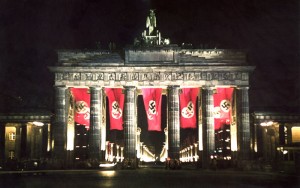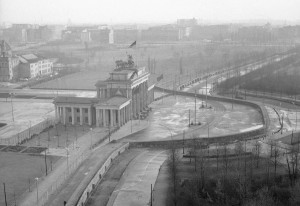When the Brandenburg Gate was first thought up in the late 18th century, the idea was to create an elaborate and grandiose entrance to the road leading to Prussian King Frederick William II’s palace (Britannica, 2016). Built at Kaiser Wilhelm’s discretion, the landmark was designed by architect Carl G. Langhans to remember the Seven Year’s War. The Gate was modeled after the Propylaea in Athens and featured 12 Doric columns carved out of sandstone along with a statue of the Greek goddess of victory Nike (Britannica, 2016). After three years of construction, the Brandenburg Gate was completed in 1791. Since its completion, the Gate has come to stand for the many parts of Berlin’s history: victory to war and division to unity.
Throughout the years, the Brandenburg Gate has been the backdrop for a series of significant political events and change. Just 15 years after the Gate’s completion, Berlin became occupied by Napoleon Bonaparte and his Grand Army as seen in the image below (Maranzani, 2013). Under Bonaparte’s command, the statue was torn from the Gate and shipped back to Paris where it remained in storage until the Prussian defeat of Napoleon in 1814 (Maranzani, 2013). When the statue was returned, an iron cross was added to commemorate the Prussian victory, further emphasizing Berlinas a place of triumph and victory.
In 1933 the Gate became a symbol of tyranny, seen below, when Adolf Hitler was appointed as Chancellor – a role leading to his powerful political climb to the Dictator of Nazi Germany. As Hitler stood on a balcony at the Reich Chancellery the night of his appointment to the chancellorship, Nazi marchers poured through Berlin streets to the Brandenburg gate (World Future Fund). This landmark was used again just six years later in 1939 for Hitler’s 50th birthday where troops marched through the gate followed by Hitler himself and lastly a parade (World Future Fund).
After Hitler and the Nazis were defeated in 1945, Germany and Berlin were divided amongst the Allies. The Brandenburg Gate fell within Soviet territory, and when the GDR constructed the wall in 1961, Berlin’s beloved Gate was separated from the West. During this period, the Brandenburg Gate took on an entirely different image: one of separation and isolation. The Gate was located in what was known as the “death strip”, the obstacle-filled area between two concrete walls on the East side that was designed to prevent escapees (Britannica, 2016). The haunting image below depicts the Brandenburg Gate as it was seen during this period: a constant reminder of the city’s division.
Despite the Wall’s ominous presence, the Brandenburg Gate’s image of division began to shift as memorable speeches given at the Gate sparked hope for the future. Two years after the Wall was constructed, John F. Kennedy delivered a speech at the western side of the Gate to show solidarity with Berlin during the tense period of the Cold War. Delivered in German, Kennedy expressed that “When all [of Berlin and Germany] are free, then we can look forward to that day when this city will be joined as one and this country and this great Continent of Europe in a peaceful and hopeful globe”(President John F. Kennedy, 1963). Twenty-four years after JFK, Ronald Reagan delivered a famous speech at the Gate, addressing America’s support for Berlin and its people (Maranzani, 2013). Reagan closed his speech with one of the most famous and hopeful lines concerning Germany and Berlin’s separation: “Tear down this wall.”
After decades of separation, the Berlin wall was opened on November 9, 1989. That night, the Brandenburg Gate restored its image of unity, becoming the playground for East and Wester Berliners who were reunited at last. Seen in the photo below, people climbed the Wall and celebrated their newfound unity, standing proudly together in front of the Gate for the first time in almost 30 years. The celebration continued for weeks, and the Gate became a site of peace and unity.
One of the most famous celebrations to take place at the Gate was the live broadcast of American conductor Leonard Bernstein’s unity concert. Bernstein conducted an orchestra composed of musicians from the four countries that occupied Berlin postwar, featuring an updated rendition of Beethoven’s Ninth Symphony titled “Ode to Freedom” (Maranzani, 2013). The first concert ended at midnight on December 23, the exact moment that the Wall became officially open for good (Maranzani, 2013). Tens of thousands of spectators gathered outside the wall to watch a live broadcast, making it the first TV event that was broadcast to both East and West Berlin in over 30 years (Maranzani, 2013).
After the fall of the wall, the Gate served as the backdrop for more positive and uplifting political speeches. In 1994, President Bill Clinton exclaimed America’s support and excitement for a “Europe united, united in peace, united in freedom, united in progress for the first time in history”(Kennedy, 1994). More recently in 2013, the Brandenburg Gate was the setting for President Barack Obama’s speech during which he reminded Berlin of their allies help during the issues of the Berlin wall and reassured them of his intentions to improve and maintain ally relationships to avoid conflicts in the future and resolve those of previous presidencies.



